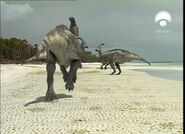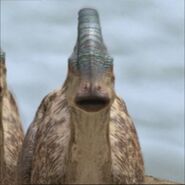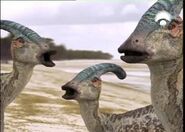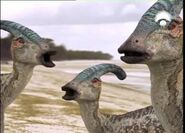| Parasaurolophus | |
|---|---|

| |
| Biological information | |
| Time period : | Late Cretaceous period |
| Lifestyle : | Herbivore |
| In the series | |
| Brought back : | None |
| Appearances : | "Supercroc" |
Parasaurolophus (name meaning "near-crested lizard") was a genus of herbivorous ornithopod dinosaur that lived during the Late Cretaceous period in what is now North America. It is famous for the long crest on its head, which it may have used to amplify its calls.
Portrayal in the series[]
Parasaurolophus is the largest ornithischian dinosaur Nigel encountered during his expeditions, measuring in at around 10 metres (32 feet) long. They are a greyish-beige in colour with dark spots and a blue crest and are portrayed as being a herd animal, travelling in groups as small as two individuals to large groups consisting of multiple individuals at different life stages. They are shown to be curious animals, and will eat most plant matter, even rope!
Parasaurolophus is also depicted as being a facultative biped, alternating between bipedal and quadrupedal locomotion depending on circumstances. They are surprisingly very quick and nimble on their feet for a creature of their size, being able to run really fast when faced with danger or needing to get to one place to another quickly.
Parasaurolophus possessed a long, tubular crest at the top of their head at all stages in life, which they use for both display and communication. The crest is hollow on the inside, as they are part of the nasal passage, and acts as a resonating chamber, which helps amplify their calls over long distances.
In Prehistoric Park[]
"Supercroc"[]
Nigel encountered a pair of Parasaurolophus early into his expedition. They curiously inspect Nigel’s jeep, and start to chew on some of the items in the back (namely the rope Nigel brought), though they show no interested in the bait meat. However, the Parasaurolophus flee when a pair of Albertosaurus appear over the hill overlooking Nigel's jeep.
Later, by the coast, Nigel encounters a herd of Parasaurolophus and watches in awe as they run past his Jeep. After the herd stops stampeding, Nigel attempts to communicate with one by using a conch shell he found in the sand. To his delight, the Parasaurolophus respond to his attempts, causing him to exclaim, “I’m talking to the dinosaurs!”
After following a Deinosuchus to the lake, Nigel saw the herd again. They were cautious near the rivers edge, knowing of what creatures lurked in the waters. One juvenile, however, strays too close to the water's edge, and is dragged into an early grave by a Deinosuchus.
The following morning, Nigel is awoken by a commotion down the lakeside and finds a trio of Albertosaurus and a float of Deinosuchus fighting over the corpse of an adult Parasaurolophus. After a short back-and-forth roaring competition, the Deinosuchus float successfully chased away the Albertosaurus trio and began feasting on the Parasaurolophus carcass.
Gallery[]
Trivia[]
- Although Parasaurolophus was not one of the animals that was brought back to Prehistoric Park, a herd of them can be seen in the intro.
- This could imply that after his adventure, Nigel went back and rescued this herd of Parasaurolophus, like how he saved 2 Nyctosaurus, which were also seen in the intro.
- However, as Parasaurolophus are known to nibble at rope, it is unclear how their enclosure would’ve been formed, as most enclosures are wood with rope holding it up.
Errors[]
- Like many other dinosaurs in the series, Parasaurolophus was depicted as having pronated hands, which would be impossible for a dinosaur.
- Parasaurolophus could have had skin attaching its crest to the back of its head (like in the image above), as some scientists have suggested, but this is a speculation.
- The juvenile Parasaurolophus in the show are shown to have fully developed crests. However, in real life, juveniles would not have the trademark crest the genus is known for, as it is a feature that only develops when they're nearing sexual maturity.
- The species of Parasaurolophus in the show was P. walkeri due to its longer and straighter crest. Like Albertosaurus, fossils of this species are found in Canada. There is no evidence that suggests P. walkeri inhabited Texas or the surrounding region 75 million years ago.
- A better replacement for P. walkeri in "Supercroc" would be the larger P. tubicen or the slightly-older, short-crested P. crytocristatus, both of which lived in the neighboring state of New Mexico around the same time the episode took place.
|
|




















